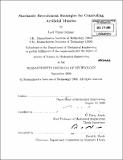Stochastic recruitment strategies for controlling artificial muscles
Author(s)
Odhner, Lael Ulam, 1980-
DownloadFull printable version (20.17Mb)
Other Contributors
Massachusetts Institute of Technology. Dept. of Mechanical Engineering.
Advisor
H. Harry Asada.
Terms of use
Metadata
Show full item recordAbstract
This thesis presents a new architecture for controlling active material actuators inspired by biological motor recruitment. An active material is broken down into many small fibers and grouped together to form one large actuator. Each of these fibers is held in a binary state, either relaxed or contracted, using a small local controller which responds to a broadcast input signal from a central controller. The output force and displacement of the actuator is a function of the number of contracted fibers at any point in time. This architecture enables the creation of large-scale, controllable actuators from highly non-linear active materials. The key innovation enabling the central controller to coordinate the behavior of very many small identical units is to randomize the behavior of each unit. This thesis explains how a collection of active material motor units responding in a random, uncorrelated fashion to broadcast commands will exhibit a predictable response that can be stabilized with feedback control and observed using a Kalman filter. Various control strategies will be presented and discussed, including open-loop plant behavior, linear feedback, optimal control, and model-based look-ahead control. Performance metrics such as accuracy and convergence time will be analyzed using dynamic programming and other control techniques. Parallels will also be discussed between this control problem and similar control problems in the field of swarm robotics. (cont.) The stochastic, recruitment-like actuator architecture is demonstrated in shape memory alloy actuators, each composed of 60 individual elements, having a displacement of over 20 mm and a peak force of over 100 N. Control of displacement, isometric force and stiffness are demonstrated using the observer-controller framework. Two actuators are used in an antagonistic fashion to control the stiffness and position of a 1-DOF arm joint.
Description
Thesis (Sc. D.)--Massachusetts Institute of Technology, Dept. of Mechanical Engineering, 2009. Cataloged from PDF version of thesis. Includes bibliographical references (p. 171-176).
Date issued
2009Department
Massachusetts Institute of Technology. Department of Mechanical EngineeringPublisher
Massachusetts Institute of Technology
Keywords
Mechanical Engineering.